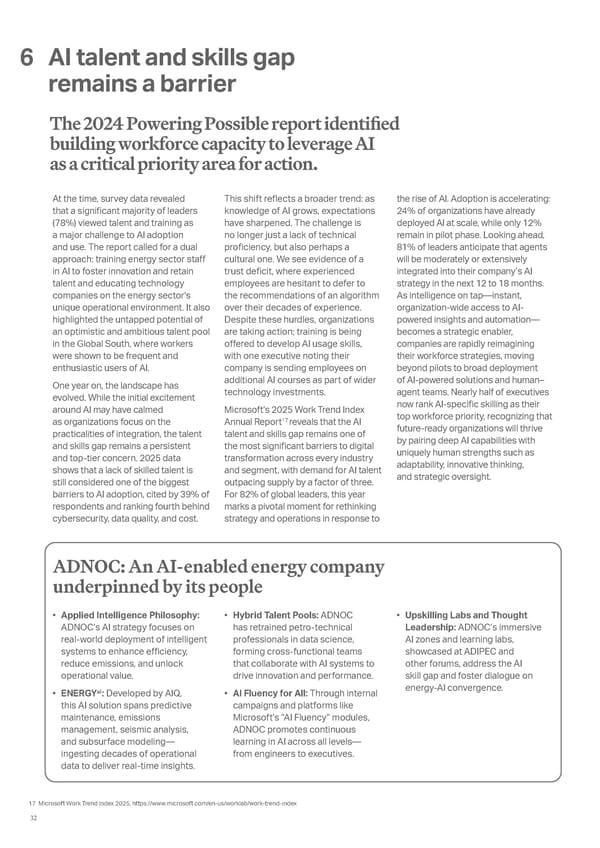At the time, survey data revealed that a significant majority of leaders (78%) viewed talent and training as a major challenge to AI adoption and use. The report called for a dual approach: training energy sector staff in AI to foster innovation and retain talent and educating technology companies on the energy sector's unique operational environment. It also highlighted the untapped potential of an optimistic and ambitious talent pool in the Global South, where workers were shown to be frequent and enthusiastic users of AI. One year on, the landscape has evolved. While the initial excitement around AI may have calmed as organizations focus on the practicalities of integration, the talent and skills gap remains a persistent and top-tier concern. 2025 data shows that a lack of skilled talent is still considered one of the biggest barriers to AI adoption, cited by 39% of respondents and ranking fourth behind cybersecurity, data quality, and cost. This shift reflects a broader trend: as knowledge of AI grows, expectations have sharpened. The challenge is no longer just a lack of technical proficiency, but also perhaps a cultural one. We see evidence of a trust deficit, where experienced employees are hesitant to defer to the recommendations of an algorithm over their decades of experience. Despite these hurdles, organizations are taking action; training is being offered to develop AI usage skills, with one executive noting their company is sending employees on additional AI courses as part of wider technology investments. Microsofts 2025 Work Trend Index Annual Report 17 reveals that the AI talent and skills gap remains one of the most significant barriers to digital transformation across every industry and segment, with demand for AI talent outpacing supply by a factor of three. For 82% of global leaders, this year marks a pivotal moment for rethinking strategy and operations in response to the rise of AI. Adoption is accelerating: 24% of organizations have already deployed AI at scale, while only 12% remain in pilot phase. Looking ahead, 81% of leaders anticipate that agents will be moderately or extensively integrated into their companys AI strategy in the next 12 to 18 months. As intelligence on tapinstant, organization-wide access to AI- powered insights and automation becomes a strategic enabler, companies are rapidly reimagining their workforce strategies, moving beyond pilots to broad deployment of AI-powered solutions and human agent teams. Nearly half of executives now rank AI-specific skilling as their top workforce priority, recognizing that future-ready organizations will thrive by pairing deep AI capabilities with uniquely human strengths such as adaptability, innovative thinking, and strategic oversight. 6 AI talent and skills gap remains a barrier The 2024 Powering Possible report identified building workforce capacity to leverage AI as a critical priority area for action. Applied Intelligence Philosophy: ADNOCs AI strategy focuses on real-world deployment of intelligent systems to enhance efficiency, reduce emissions, and unlock operational value. ENERGY ai : Developed by AIQ, this AI solution spans predictive maintenance, emissions management, seismic analysis, and subsurface modeling ingesting decades of operational data to deliver real-time insights. Hybrid Talent Pools: ADNOC has retrained petro-technical professionals in data science, forming cross-functional teams that collaborate with AI systems to drive innovation and performance. AI Fluency for All: Through internal campaigns and platforms like Microsofts AI Fluency modules, ADNOC promotes continuous learning in AI across all levels from engineers to executives. Upskilling Labs and Thought Leadership: ADNOCs immersive AI zones and learning labs, showcased at ADIPEC and other forums, address the AI skill gap and foster dialogue on energy-AI convergence. ADNOC: An AI-enabled energy company underpinned by its people 17 Microsoft Work Trend Index 2025, https://www.microsoft.com/en-us/worklab/work-trend-index 30
 Powering Possible 2025: Unleashing AI for Energy and Energy for AI Page 29 Page 31
Powering Possible 2025: Unleashing AI for Energy and Energy for AI Page 29 Page 31